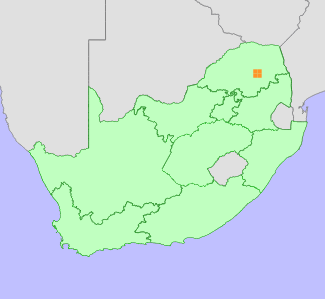|
Scientific Name | Afroaster nubimontis (W.Lippert) J.C.Manning & Goldblatt |
Higher Classification | Dicotyledons |
Family | ASTERACEAE |
Synonyms | Aster nubimontis W.Lippert |
National Status |
Status and Criteria | Endangered A2c; B1ab(iii)+2ab(iii) |
Assessment Date | 2022/11/10 |
Assessor(s) | L. von Staden & P.J.D. Winter |
Justification | An estimated 50-70% of its habitat has been lost in the last three generations (60-90 years), mainly due to afforestation. At present there are three to four remaining locations in grassland fragments amidst extensive plantations. These fragments are being continually degraded due to unsuitable fire management and invasion by woody alien species, mainly pines and wattle. One locations is potentially threatened by mining. The extent of occurrence (EOO) is estimated to be 120 km² and the area of occupancy (AOO) is estimated to be less than 20 km². It therefore qualifies to be listed as Endangered under criteria A and B. |
Distribution |
Endemism | South African endemic |
Provincial distribution | Limpopo |
Range | This species occurs in Wolkberg Plateau and Woodbush. |
Habitat and Ecology |
Major system | Terrestrial |
Major habitats | Woodbush Granite Grassland, Northern Escarpment Quartzite Sourveld |
Description | Plants grow on rocky outcrops in mistbelt grassland, above 1600 m. |
Threats |
| This species has a restricted range in one of the areas most extensively impacted by forestry plantations in South Africa. Grasslands above 1600 m within the known range of this species were already 58% transformed by 1996 (estimated using GIS), but very little documented information is available on when the plantations were established. It is assumed that the majority of plantations were established since 1900. Recent satellite images indicate that there is ongoing habitat loss due to the establishment of new plantations. A further 44% of the remaining habitat has been transformed since 1996. Recent visits to sites where this species occurs indicate that they are being continually degraded by unmanaged alien invasive Pines and Wattles. One site is also potentially threatened by mining (P.J.D Winter pers. comm.). |
Population |
Population trend | Decreasing |
Conservation |
| No known localities fall within protected areas. |
Assessment History |
Taxon assessed |
Status and Criteria |
Citation/Red List version | | Afroaster nubimontis (W.Lippert) J.C.Manning & Goldblatt | EN A2c; B1ab(iii)+2ab(iii) | 2014.1 | | Aster nubimontis W.Lippert | EN A2c; B1ab(iii)+2ab(iii) | Raimondo et al. (2009) | | Aster nubimontis W.Lippert | VU D2 | Victor (2002) | | Aster nubimontis W.Lippert | Insufficiently Known | Hilton-Taylor (1996) | |
Bibliography |
Hilton-Taylor, C. 1996. Red data list of southern African plants. Strelitzia 4. South African National Botanical Institute, Pretoria.
Lippert, W. 1973. Revision der gattung Aster in Afrika. Mitteilungen der Botanischen Staatssammlung München 11:153-258.
Manning, J.C. and Goldblatt, P. 2012. Plants of the Greater Cape Floristic Region 1: The Core Cape Flora. Strelitzia 29. South African National Biodiversity Institute, Pretoria.
Raimondo, D., von Staden, L., Foden, W., Victor, J.E., Helme, N.A., Turner, R.C., Kamundi, D.A. and Manyama, P.A. 2009. Red List of South African Plants. Strelitzia 25. South African National Biodiversity Institute, Pretoria.
Retief, E. and Herman, P.P.J. 1997. Plants of the northern provinces of South Africa: keys and diagnostic characters. Strelitzia 6. National Botanical Institute, Pretoria.
Victor, J.E. 2002. South Africa. In: J.S. Golding (ed), Southern African plant Red Data Lists. Southern African Botanical Diversity Network Report 14 (pp. 93-120), SABONET, Pretoria.
|
Citation |
| von Staden, L. & Winter, P.J.D. 2022. Afroaster nubimontis (W.Lippert) J.C.Manning & Goldblatt. National Assessment: Red List of South African Plants version 2024.1. Accessed on 2025/12/23 |
 Comment on this assessment
Comment on this assessment


